The Yellow Horse is a curious little song air. We have three independent transcription notations of variants or versions of this tune, under two different titles, in Edward Bunting’s transcription notebooks from the 1790s. They are all three a bit tricky to understand.
The page 96 “Garron Buoy” transcription
Bunting made what looks like a live transcription notation of the tune of An gearrán buidhe on Queen’s University Belfast, Special Collections, MS4.29 page 96. This notation is a bit messy in places, and so he made a neat copy on the facing page 97.
Let’s look at what I think is the live transcription notation on p.96. The top half of the page is a different tune, Cúileann fín. Our tune is titled halfway down the page “Garron Buoy”:
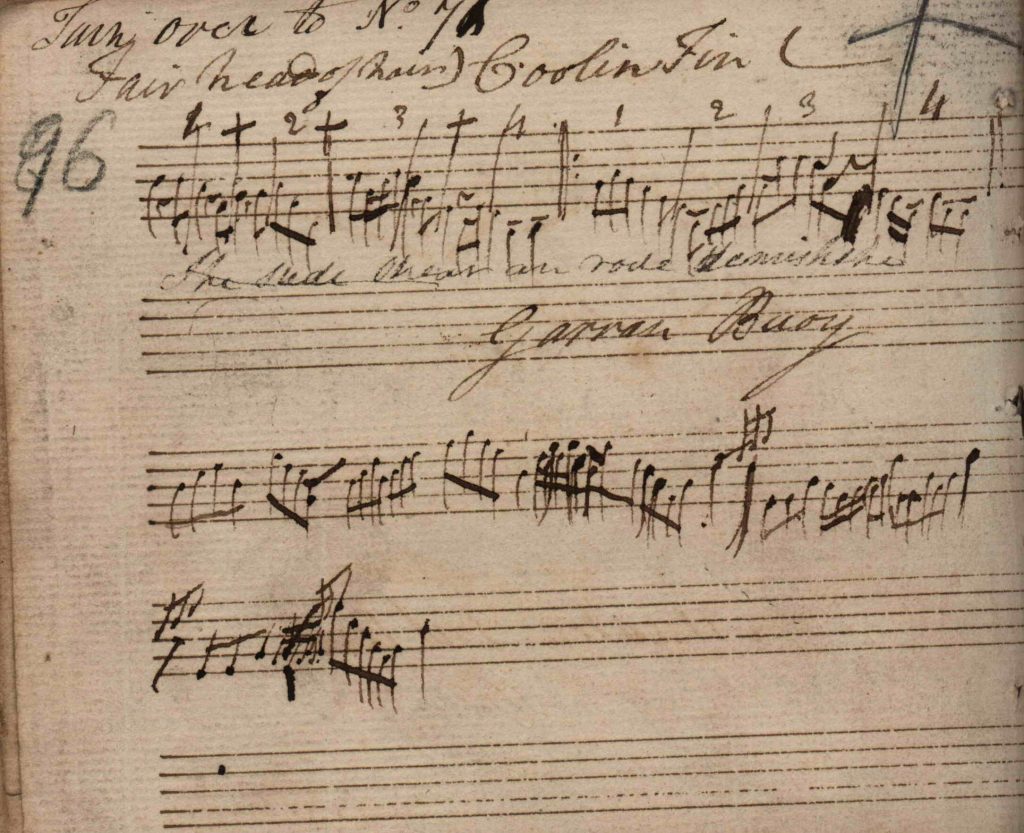
This notation seems to be in E minor, with an implied key signature of one sharp. I am trying to follow the underlying dots here. Bunting has over-written the initial dots; at first I thought he was just correcting transcription errors but I feel he may have been trying to push the tune into a different key, as we can see if we look at the copy and other later developments. Of course, this means that there are many questionable choices I have made in my transcription and machine audio, and it may well be useless and corrupt.
Bunting’s neat copy is on the facing page, but he has put it into a different key completely, shifting everything three positions down. To me this looks like it is in B♭ major, with an implied key signature to make all the Bs flat.
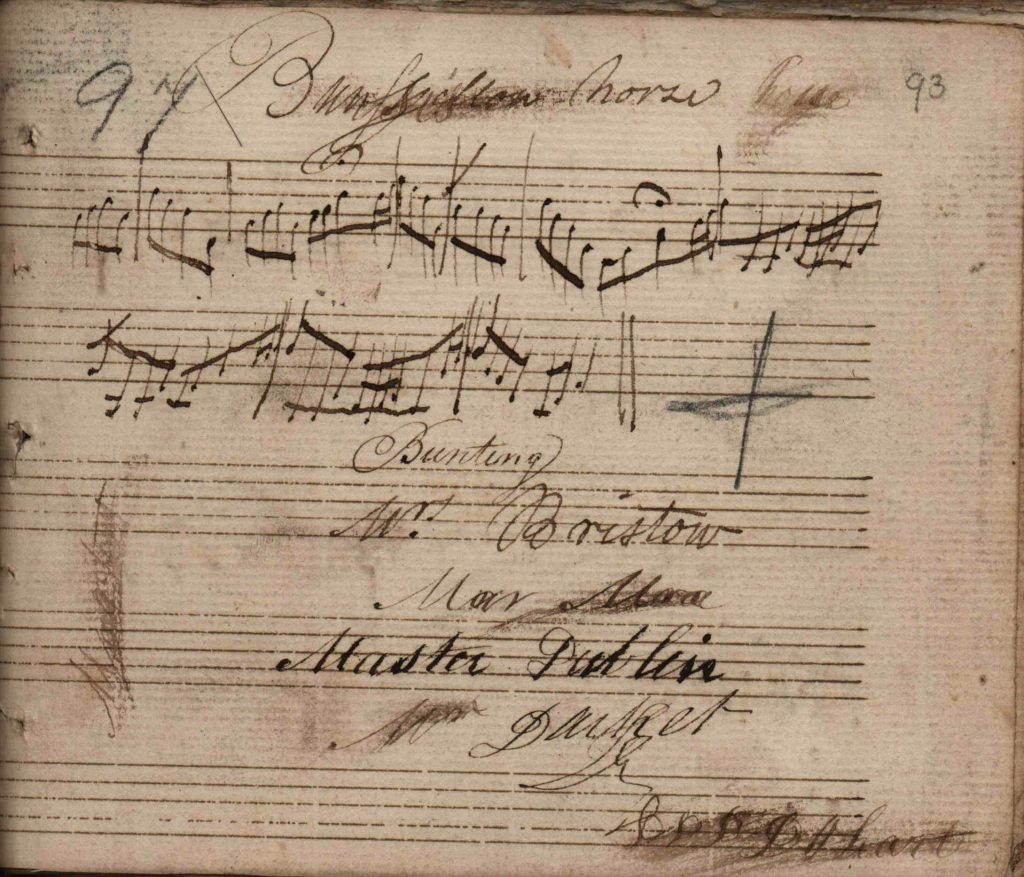
I only put one flat in the key signature for this machine audio, and so it has the sharp seventh. But I could equally have put three (there is no E in the notation) to get the flat 7th, A♭. Or we could follow the implied minor key of the transcription. I don’t really know how to handle this. Has Bunting just decide to make everything major?
We can see Bunting getting control of the rhythm and timing of the tune. But I am always dubious of the subtle changes of the note timings and pitches that are introduced in these copies. It is tempting to imagine Bunting accurately writing a neat version of exactly what he heard from the tradition-bearer sitting beside him, but I think it may be more likely that he is “correcting” what he thinks of as a deficient or confusing rendition, as the first step in de-traditionalising the tune for the ultimate aim of making a commercial piano arrangement for his published books.
The page 187 “Bean an leanna” transcription
Bunting made what looks like a live transcription notation of a variant of our tune on QUB SC MS4.29 p.187, titled “Bhanna Lanna the Woman / with the ale”.
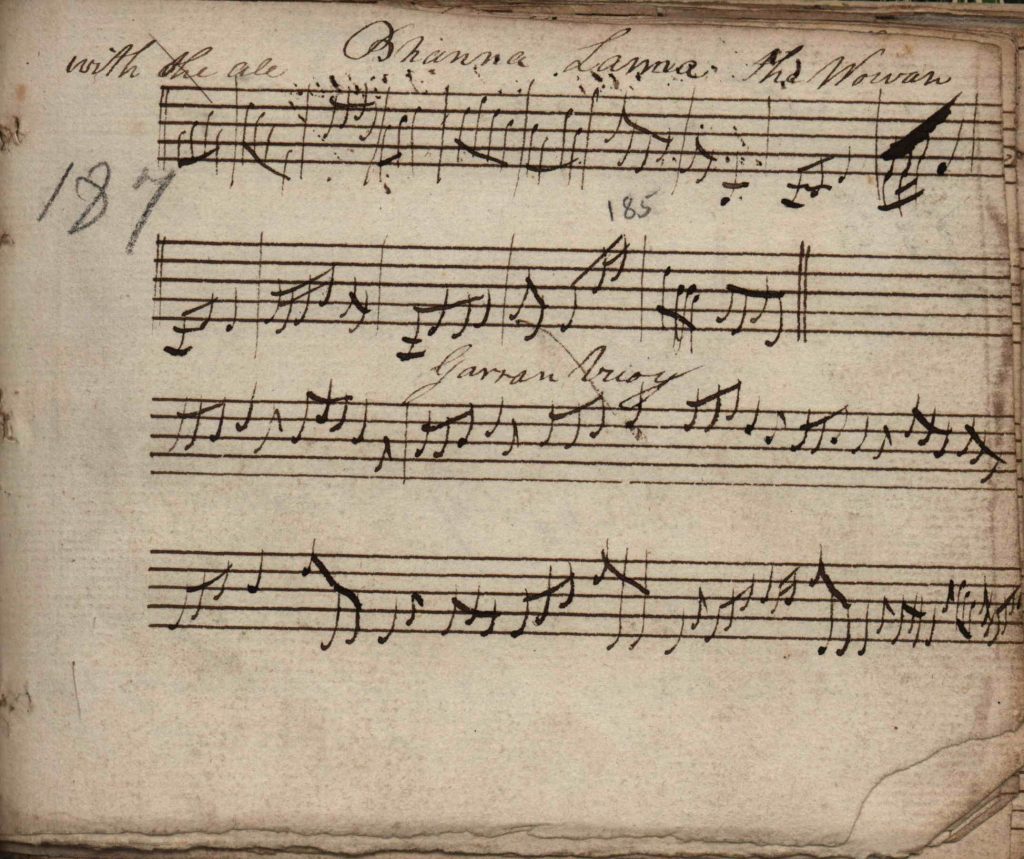
This looks to me like a very straightforward live transcription from the performance of a traditional informant. I imagine Edward Bunting first of all dotting along the dots live as the informant played or sang, and then going back straight away to add in the note stems, beams, and barlines.
The tune seems very straightforwardly written at pitch, in D major pentatonic mode. If it was notated from a harp performance, it would have required F♯ to be tuned on the harp, and would most likely have had a flat 7th (C♮) as shown in my typeset version.
The page 187 “Garran buoy” transcription

As with the other tune on this page, this seems a straightforward simple transcription, at pitch, in D major pentatonic. The same comments about the 7th apply here as well.
The 1798 piano arrangements
I think in 1798, Bunting made a pair of piano arrangements which are derived from these transcriptions. They are in his unpublished 2 volume Ancient and Modern collection which is now QUB SC MS4.33.3 and MS4.33.2. Our tunes are on MS4.33.2 p.11.
The top half of the page is derived from the MS4.29 p.96 “Garron Buoy” transcription. Its title here is “No.57 / Gearran Buidhe or yellow horse / From Hugh Higgins”, and at the top he has written in pencil (probably later) “Dr Crawford has the words”.
The lower half of this page is derived from the MS4.29 p.187 “Bhanna Lanna” transcription. The title here is “No. 58 / Bhanna Lanna – the Woman with Ale – very Ancient / From Charles Byrne”, and Bunting has commented “Those Two airs the same”.
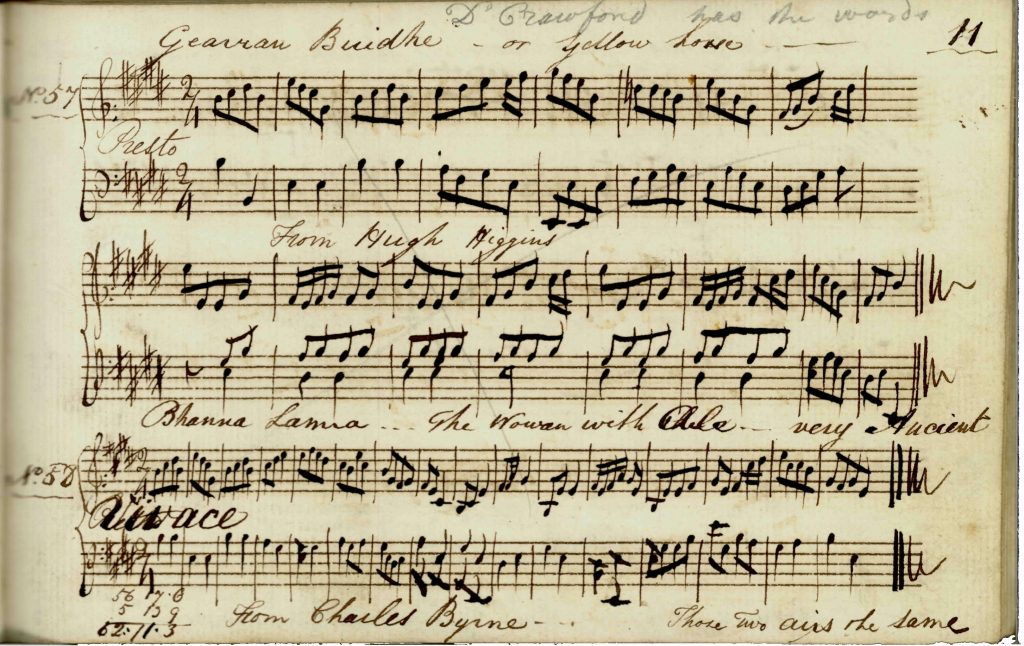
You can see that An gearrán buidhe is the same place on the staff as the initial live transcription, and Bunting has given us a key signature of four sharps to make the tune sit in E classical major key. We get a flat 7th in bar 6 but that is part of the harmonic progression of the piano arrangement, so I don’t think we can tell anything about sharp or flat 7ths from this arrangement.
Bean an leanna has been put in the same key signature of E classical major, with four sharps. Here, the sharp 7th is continued all the way through the tune. I wonder if this tells us something about how to read the transcriptions, or if this is just Bunting’s classical mind making it suit the piano better?
Even though these manuscript settings look very simple, they are nonetheless piano arrangements and we should treat them as such.
Bunting’s 1809 piano arrangement
On page 12 of his 1809 Collection, Bunting prints two arrangements, both under the collective title “Gearan Buiidhe / Gearan Buidhe – Yellow horse”. We can recognise the first one on this page as Bean an Leanna, derived from the p187 transcription, though Bunting has now completely dropped the Bean an Leanna title. The second one, headed “Another Edition”, is An gearrán buidhe, derived from the p.96 transcription.
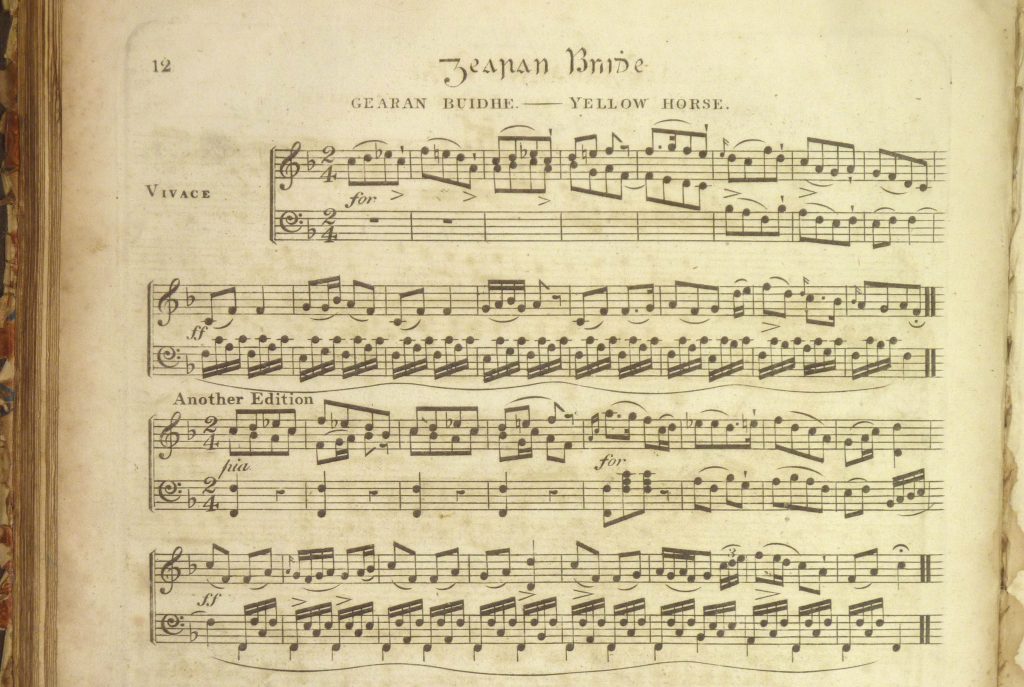
I think that both of these have gone so classical and pianistic that there’s not much more we can say about them.
Other versions of the tune
There is another independent set of An Gearrán Buidhe, which was written out in a presentation book for Bunting, by piper and tradition-bearer James Cody between 1805 to 1809. Cody’s title is “Gearán Buídhe” and his tune is in 6/8 time. Its second half is a little different from the two MS4.29 transcriptions, and it is in a strange mode.
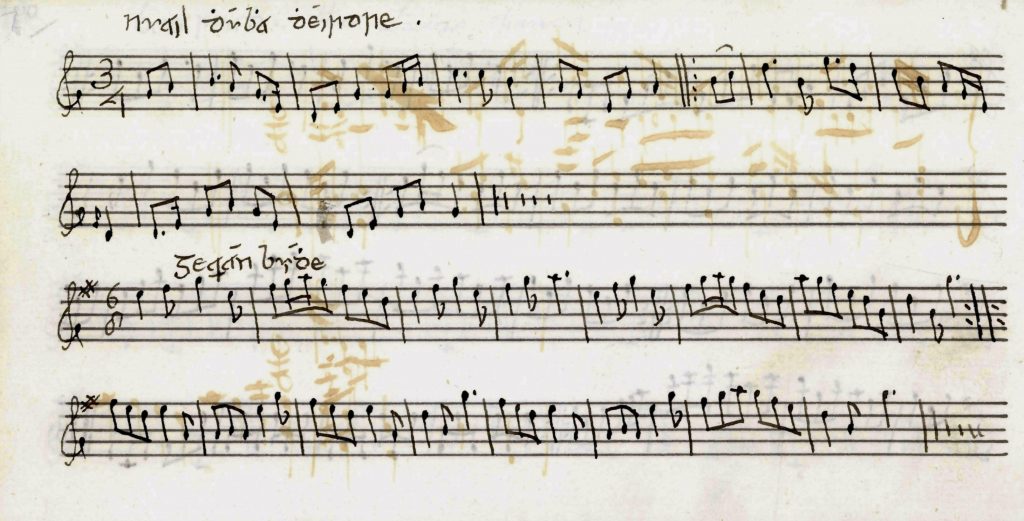
Cody has written a double repeat mark at the end of the first line but he always does that, without a closing repeat mark at the end of the tune, and I think he is just using it as a decorative double bar line rather than meaning to repeat each half. My machine audio does not repeat the first half.
Colette Moloney, in her Introduction and Catalogue (2000) p. 197, notes Bunting writing the title “Gurron buoy” in amongst the military tunes in Cody’s rough book (MS4.6) but I have no idea what this means. I haven’t seen this page. Colette also notices a version of our tune in QUB SC MS4.12 (Moloney p.247) which seems to be a classical version. I haven’t looked at this.
O’Neill printed a version in 1903 which may well have been derived from Bunting’s 1809 print; it is No. 405, on page 70. The interesting thing here is that his title is “An Garran Buidhe / The Yellow Garron” as if he did not know the Irish word “Gearrán”.
Stanford-Petrie has four different versions of our tune which are all quite interesting. No.577 is titled “The yellow Horse / from an old MS” which seems more distantly related; no.1456 “Gearán buídhe / from Miss Ross” seems very distant from ours; no.1457 “An Gearán buídhe” is fairly close but starts with our second half; and no.1458 “An Gearán buídhe / As in a MS of 1780” which seems reminiscent of ours. I’m sure there are more out there but that’s enough for now.
There are lots of other tunes with “yellow horse” titles but without any connection to our tune.
There are also other tunes with the “woman with ale” title. There is a manuscript in Bunting’s collection (though I don’t think it is his handwriting) with a tune titled “Ban a Lanna or the Ale Wife”, in QUB SC MS4.30.023. I don’t think this is related to our tune.
Song
I haven’t found any song lyrics about the yellow horse. Donal O’Sullivan notes the tune, An Gearrán Buidhe, is specified for a song lyric by the Munster Poet, Seán Ó Murchadha (1700-1762) which indicates that it was well known as a song air. (Tadhg Ó Donoghue (ed), Dánta Sheáin Uí Mhurchadha, na Ráithíneach (Connradh na Gaedhilge, 1907 song 38, p.97: “XXXVIII – Spás le haér / Scléip Shéamuis mac Liam de Barra, Baile na gCloch. / Fonn – An Gearán Buidhe…”)
A song about the woman with ale (i.e. the landlady or alewife) is well known in the tradition. It is not clear to me if our tune is related to this song. You can listen to a version sung by Joe Heaney which also gives text and translation.
Attributions to harper informants
There is no clue or tag on either the page 96 transcription, or the two p.187 transcriptions, but we can use two different methods to try and work out what they represents. One is to look at the context of the pages within the transcription manuscript, and what is on nearby pages, and the other is to look at the attribution tags on Bunting’s later piano derivatives.
We looked above at Bunting’s process of transforming the transcription notation into a published piano arrangement. When Bunting went through the printed books, probably in the early 1840s, writing attributions against each tune, he did not write anything at all against either of the two tunes on the top half of page 12 under the title “Gearan Buidhe”, neither the first tune, Bean an leanna nor the second tune, which is derived from our transcription of An gearrán buídhe (BL Add ms 41508). So that’s no help. But, in he tagged his 1798 manuscript piano version which is derived from this transcription; against An gearrán buidhe he writes “from Hugh Higgins”, and against Bean an leanna he writes “from Charles Byrne”.
If the p.187 transcription of Bean an leanna was made live from Charles Byrne, does that mean that Byrne was also the informant for the p.187 transcription of An gearrán buidhe? If we look at my Old Irish Harp Transcriptions Project Tune List Spreadsheet in conjunction with my MS29 index and transcript PDF we can see that it sits at the beginning of a distinct section of the manuscript, with margins on the inside and top edges of each page. Most of these items are not securely attributed but there are are fair few that I am tentatively suggestion may be from Byrne, many of them vocal in style, from pages 186 through to 200. So, we could tentatively believe Bunting’s attribution tag here.
But what about the other transcription on page 96? We know that Hugh Higgins died in 1796, and it seems to me that Bunting may have only collected tunes from him in the summer of 1792. So is that when the MS4.29 p.96 transcription of An Gearrán Buídhe was done, from Higgins’s harp playing?
I mentioned in my last post, on An londubh agus an chéirseach, about the tune list on QUB SC MS4.29 p.178 attributing tunes to Daniel Black. The list includes the title “Garran buoy yellow horse” but it also includes the titles of four other tunes which are on the group of manuscript pages around our transcription, on pages 93 through to 96 of MS4.29. So we have to at least suspect that this entire group of pages may have been part of the pamphlet that Bunting used when he was transcribing from Black. We know that Bunting transcribed tunes from Black at Glendaragh House, near Crumlin, in the summer of 1796. So I think it is at least possible that the page 96 transcription of An gearrán buidhe may have been transcribed from Daniel Black.
Of course it’s possible that neither of these two possibilities is what actually happened. Bunting could have made the p.178 tune list to record the tunes that Black played, without making fresh transcriptions from him; he could have added the Higgins attribution to the piano manuscript, based on his memory of Higgins playing the tune; he could have made this page 96 transcription of Gearrán Buidhe from a third different harper, without making a note of who or when this was. I don’t think there is really any way to tell for certain.
And finally, we know that Byrne, Higgins, and Black all sang. So it is quite possible that the three transcriptions in MS4.29 might all be from purely vocal versions of the tune, and if so they would tell us nothing about old Irish harp style and idiom
Many thanks to Queen’s University Belfast Special Collections for the digitised pages from MS4 (the Bunting Collection), and for letting me use them here.
Many thanks to the Arts Council of Northern Ireland for helping to provide the equipment used for these posts, and also for supporting the writing of these blog posts.
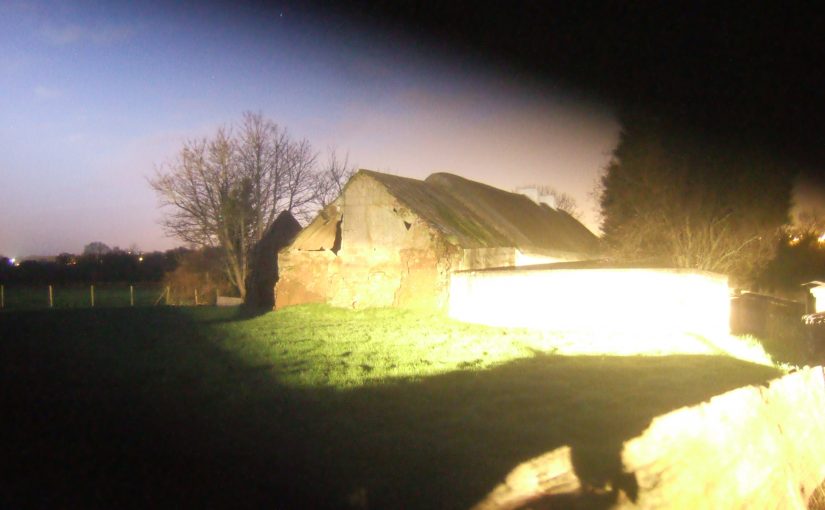

One thought on “An gearrán buidhe”